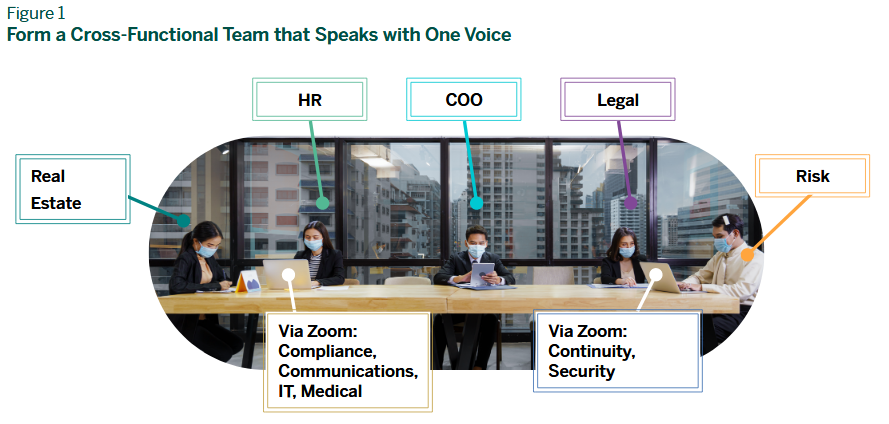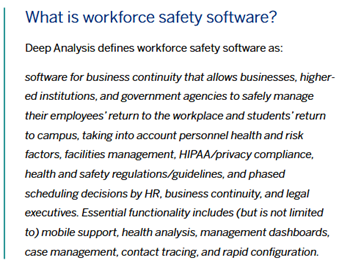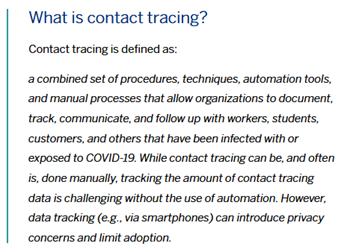Return-to-Work Best Practices for Business, Gov & Higher Ed
The Essentials
Who: Businesses, government agencies, and higher-ed institutions that suspended on-premises operations in spring 2020 because of COVID-19 and remain fully or partially closed, especially in the US where cases continue to climb and reopening guidance fluctuates daily.
Challenge: How to develop a return-to-work or return-to-campus plan that keeps everyone safe, meets regulatory, compliance, and privacy guidelines, and addresses employee/customer concerns even while the organization is under pressure to reopen for business continuity.
Solution: Based on advice from early adopters, best practices include: create a single cross-functional team to investigate and decide on workforce (or student) safety software options; develop a flexible plan that addresses workforce concerns and compliance regulations; and communicate with one voice so as not to confuse employees and students.
Keeping People Working Off-site Creates a Push/Pull
2020 has been a really sad, weird year for everybody: the general population, business operations, employees, contractors, customers, students – even athletes and entertainers. Buildings and other assets throughout the world have been closed or only partially open because of stringent COVID-19 precautions. As a result, millions of workers have stayed away and worked from home, while millions of others are working on-premises but with many precautions and restrictions.
The “push” to reopen businesses, agencies, and campuses is driven by a very real need for continued revenues and profits by maintaining business continuity. Business leaders and educators want to reopen safely, but most of all they want and need to resume safe normal operations as quickly as feasible.
The “pull” to stay distanced by working from home springs from employee fears and reluctance to re-enter shared spaces in physical offices, buildings, warehouses, plants, campuses, and retail stores, as well as management concerns for protecting workers and students. Workers’ desire to remain distanced may also stem from worries about external challenges that employers don’t control, such as avoiding infection on crowded public transportation to and from work, or needing childcare during work hours.
Industries that continue to operate with a quasi-full or slimmed-down on-site workforce include healthcare, manufacturing, pharma, distribution/logistics, and retail. In contrast, organizations in sectors such as insurance, government, or high-tech, with largely white collar workers, have transformed overnight into a virtual workforce. Higher-ed campuses are a mixed bag, with many in the US shutting down on-campus classes after hot spots emerged, and also offering a range of online or blended courses. All of these organizations need to monitor workforce safety, including possible employee, contractor, or student exposure to the virus; testing; those in quarantine; contact tracing; physical safety in buildings, on campuses, in corporate fleets, etc.; and updated regulatory guidelines
Start with a Multidisciplinary Executive Team that Speaks with One Voice
Returning to work is not a simple issue. It can’t be solved by one dedicated business leader or, conversely, by a cacophony of leaders tackling isolated components of a reopening strategy. Instead, a comprehensive plan that clearly communicates the scope, purpose, precautions, and timelines requires a number of executives working together to successfully and safely reopen. Lessons learned from teams that have already done this include the following:
Task the COO, the Chief People Officer, or an equivalent C-suite executive to lead a multidisciplinary executive team. This team must involve all the relevant executive stakeholders in the return-to-work planning and execution process. These stakeholders are drawn from, but not limited to, HR, business continuity, real estate, legal counsel, risk management, and medical expertise. If the organization is 3Return-to-Work Best Practices for Business, Government, and Higher Ed © 2020| info@deep-analysis.netDeep Analysisin higher ed and has a medical school, the Dean of Public Health is a good candidate to lead the multidisciplinary team. The team’s purpose is to get inputs and insights from across the organization and to develop a comprehensive plan rather than multiple piecemeal plans. (If your organization is having difficulty pulling a single team together, think of this effort as similar to creating a multidisciplinary stakeholder team to tackle business transformation, end-to-end processes, or digital transformation.)

Speak with one voice and communicate, communicate, communicate. Because return-to-work is so multifaceted, there’s a danger that leaders with overlapping responsibilities could contradict each other and confuse the workforce. For example, the real estate team may be canceling leases and downsizing offices while the HR leader is planning a phased reopening for those sites. This is a time when communication, coordination, and collaboration among business leaders is essential.
In many ways, return-to-work or reopening is a massive adaptive change management effort. Typically, those practitioners reside in HR. Some of the reopening policies may be temporary (e.g., a phased return to work) or others may be permanent (increasing the numbers of teleworking employees). The most persistent advice any change management practitioner will give executives is to communicate,communicate, communicate. And when you think you’ve communicated enough, do it some more!
Take a global perspective even if the business has a small global footprint. Not all employees will return to work in office buildings when the organization reopens. Instead, they may need to fly, truck, train, or drive to off-site locations to meet with customers, business partners, government leaders, etc. The guidelines, regulations, and restrictions for the movement of people vary greatly across countries and regions and sometimes change as the spread of the disease changes. Issues such as closed airports, border restrictions, supply chain failures at remote regions, new regional quarantines, and curfews must be taken into account. If the organization has a small global footprint, reopening leaders may not realize some of the restrictions that apply to corners of the organization. And for a multinational business, reopening must take into account guidance in each locality, country, and continent.
Look at the big picture no matter the size of the business. If the organization has limited international operations involving the workforce, reopening leaders may be unaware of restrictions in far-flung areas that could impact the reopening plan or ongoing operations. If the organization is a multinational business, reopening must take into account workforce (and customer-related) guidance in each locality, country, and continent, recognizing that guidance, regulations, and enforcement may fluctuate around the globe. Given that business processes often span borders and involve overseas workers in at least parts of the process, the impact of closing and reopening may be greater than the reopening team realizes.


Knowing When and How to Reopen Is the First Step
Reopening vs. continuing to work remotely is an extremely challenging management and workforce dilemma that calls for strong executive leadership, operational excellence, and deep adaptive change management skills. COVID-19 has created a sudden urgent need for insightful and flexible management approaches, challenging most organizations in ways they have never been tested. To successfully navigate the many known and unknown pitfalls, leadership should:
Go into reopening with an extremely flexible mindset. Deciding when and how to safely reopen is not simple. Depending on how quickly the virus spreads in a given location, organizations may need to roll back their return-to-work policies soon after starting to reopen. A good example is the on-again/off-again approach by many US colleges and universities this year: bringing students to campus only to close their facilities almost immediately. The overall lesson learned is this: the need for speed does not outweigh the need for caution.
Survey and quantify the workforce, students, or customers to determine attitudes and readiness for reopening.This may involve asking employees to self-report their wellness and exposure to the virus. (This is a major reason why rolling out self-reporting workforce safety software often goes hand-in-hand with canvassing the target population.) Some issues that are bound to surface include at-risk workers who have chronic conditions or are over 65, and workers who will have child-care needs when re-opening occurs.
Whenever possible, make returning to work voluntary and phased. This is commonsense advice because of social andphysical distancing requirements, as well as physical security and sanitizing operations. Many organizations plan to use a three-stage (or a more protracted multi-stage) return-to-work approach, with the first wave comprising volunteers who are eager to return, the second wave including the majority of remaining healthy employees, and the third (or semi-permanent) wave encompassing high-risk employees with compromised immune systems or high-risk indicators.
Recognize that customers play a critical role in some industry reopenings. The pace and strategy for reopening often depends on how frequently employees engage face-to-face with customers. Retailers, restaurant chains, and healthcare providers obviously must plan for customer or patient safety, which could include physical accommodations within buildings or shifting to virtual sessions (e.g., online conferences, telemedicine, home delivery). Some face-to-face interactions at the customer’s residence may be less obvious, such as real estate appraisals, mortgage closings, and interior design/deliveries. Business process reviews that analyze how standard procedures can be manually modified or supported by software and process changes are very helpful.
Tackle the Hard Issues that Arise When It’s Not Business As Usual
Undoubtedly there will be fear, uncertainty, and doubt among workers and students impacted by COVID-19 closures and reopenings. Not only will HR often be tapped with leading the reopening process, but HR will also need to deal with many workforce training and procedural issues, such as these:
Be aware of the potential for tension among workers, such as between employees with children and those without. Reopening, even in phases, is just the beginning of many potential HR issues that may surface. For example, already, employment compensation problems have surfaced in Silicon Valley and elsewhere because employees who are childless or who have someone to look after their children while they work sometimes resent colleagues who are unable to work full-time because of childcare and home-schooling obligations. Corporate culture and existing HR guidelines play a dominant role in how companies navigate potentially tricky employee relations and compensation. This lesson underscores the need for HR to take the lead in developing the timeline and categories of workers to return to the worksite versus those who remain virtual.

Recognize the need for technology training. Even after six months of remote working, technology gremlins abound as employees try to use enterprise apps on low-speed internet connections, install new wi-fi equipment they know little about, rely on new tools without formal training, and figure out how to make business applications work when gaps appear in a business process. These gaps surface, for example, when the work involves manual, paper-intensive steps that are hard to do from home and/or on-site steps that are impossible to do from home. Someone needs to think these business processes and situations through because workers are already stressed out, and imperfect work environments with cobbled-together collaboration tools only add to the pressure. Do not assume that workers know how to resolve technology challenges and suddenly broken processes.
Use Workforce Readiness and Safety Software to Track Employee Health and Building Safety
Trying to manage the health and safety of thousands of employees or students using spreadsheets, Word documents, and email is nonsensical. On the other hand, trying to build an effective technology solution in-house is equally foolhardy because of the complex requirements and impossibly short timeframes. That’s why most large organizations decide that workforce safety software is de rigueur for safely reopening.
 To get started on this path, follow these steps:
To get started on this path, follow these steps:
1. Determine if the organization needs software for workforce health self-reporting, contact tracing, or both. Contact tracing is recognized as a highly effective tool to slow the spread of COVID, but it is extremely complex, creates societal concerns about privacy and big brother, and in some locations can only legally be done by the government. Moreover, the cost of software with contact tracing is at least double the cost of software for employee self-reporting and building management. (Note that digital contract tracing is a potentially new market for high-tech vendors.) In some instances, such as retail, logistics, manufacturing, and transportation, contact tracing could be crucial and a key software requirement. However, some businesses will find it most feasible to notdo contact tracing unless it is required, particularly since manual contact tracing is extremely slow and labor intensive. Instead, they can focus on software that tracks employee health daily and ensures buildings are kept secure, sanitized, and accessible only to those who qualify based on self-reporting their health.1
2.Conduct a software buy-versus-build analysis. Realistically, organizations need reopening software now or in the very near future. This makes a buy decision significantly more attractive than building an in-house application, keeping in mind that it will take time to test, implement, and customize even an out-of-the box solution, much less a custom app. The process is complicated and, for all but the smallest organizations, software can help immeasurably. CIOs usually take the lead in sourcing, configuring, deploying, and supporting the application – whether it is commercial or custom-developed software.
3.Evaluate workforce safety and readiness software applications. Keep in mind that these software solutions are brand-new products that were developed in response to the pandemic. In some cases, the software may be built upon established platforms with track records using case management, digital process automation, and document management products.
4.Review the four technology approaches for building or buyingworkforce safety have to copy and past software:
-
Use frameworks, templates, and best practices from existing software suppliers, such as digital process automation software (e.g., Pegasystems, Hyland, Nintex). This approach is not completely out of the box and requires additional development and configuration. It also requires that the organization already have a platform in use from the vendor.
-
Build a business application (e.g., JavaScript) in IT following traditional development and testing processes. This is a more time-consuming approach than using frameworks, existing collaboration tools, and SaaS solutions.
-
Buy a cloud-based workforce safety and readiness application, preferably a SaaS solution that does not require existing platforms from the vendor (e.g., Appian and Salesforce).
-
Build a lightweight app using personal productivity tools (e.g., Microsoft Office); this might be a fast, inexpensive path to a solution but will most likely be incomplete compared to out-of-the-box commercial products.
 Comply with Health Data Privacy Regulations When Using Workforce Safety Software
Comply with Health Data Privacy Regulations When Using Workforce Safety Software
Many organizations are shocked to learn of the numerous compliance regulations that go hand-in-hand with tracking the health of the workforce or student body. Asking employees to self-report their temperatures, symptoms, testing status, and quarantine status – much less who they have been in contact with – makes the organization responsible for a lot of highly sensitive private data and for complying with HIPAA or FERPA (in the case of higher ed) regulations. This cannot be overlooked; it only takes a quick trip to the doctor’s office to see the amount of tracking, paperwork, and security involved in protecting health data. Tracking compliance is where the chief legal officer, risk management officer, and business continuity executive get involved in reopening; including them from the beginning is essential.Compliance is crucial for every organization and is made more complicated in multinational companies because of additional regulatory bodies (e.g., GDPR in Europe).
Some of the compliance regulations that may apply include:

Call to Action
Reopening buildings and returning the workforce to on-site locations is not a simple process. These lessons learned can be summarized as three major calls to action:
Leadership: Build a multidisciplinary executive team, headed by a senior executive (COO, HR, Dean of Public Health), determine the scope and scale of the return to work, and speak with one voice.
Software: Some type of tracking software will be needed. Depending on the size of the organization and the need for moving fast, put packaged software ahead of in-house development.
Regulations: Do not ignore the need to follow regulations; self-reporting means that the organization is now responsible for protecting employee (or customer/student) health data privacy. Also, look beyond HIPAA (and FERPA) to other applicable regulations such as GDPR for organizations that operate in Europe.
About Deep Analysis
Deep Analysis is an advisory firm that helps organizations understand and address the challenges of innovative and disruptive technologies in the enterprise software marketplace. Its work is built on decades of experience in advising and consulting to global technology firms large and small, from IBM, Oracle, and HP to countless start-ups. Led by Alan Pelz-Sharpe, the firm focuses on Information Management and the business application of Cloud, Artificial Intelligence, and Blockchain. Deep Analysis recently published the book "Practical Artificial Intelligence: An Enterprise Playbook," co-authored by Alan and Kashyap Kompella, outlining strategies for organizations to avoid pitfalls and successfully deploy AI. Deep Analysis works with technology vendors to improve their understanding and provide actionable guidance on current and future market opportunities. Yet, unlike traditional analyst firms, Deep Analysis takes a buyercentric approach to its research and understands real-world buyer and market needs versus the “echo chamber” of the technology industry.

Connie Moore
Connie Moore is Vice President and Principal Analyst at Deep Analysis. She joined the firm after four years as Senior Vice President, Research, at Digital Clarity Group, and more than twenty years as Research Director and Vice President at Forrester Research. Connie is a widely acclaimed speaker, advisor, consultant, and expert in digital process automation, customer experience management, digital experience platforms, and content services.